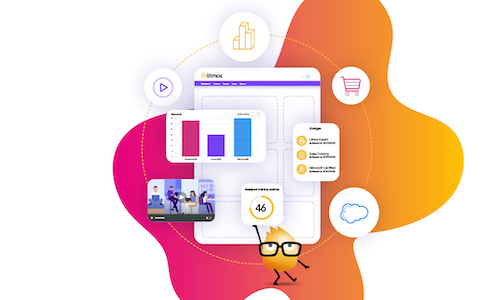7 Steps for Creating a Sales Training Program
Sales is one of those jobs that can be mythologized and made into a mysterious magical art. Either a salesperson is naturally very good at sales, or they’re not. They “have it” or they don’t, right?
This is obviously not the case. Sales is a collection of skills, and those skills can be taught. Sure, some of those skills might come more easily to certain salespeople, but given the right training, all of your reps can master the dark art of closing a deal.
Even though all sales teams can benefit from training, not all organizations offer formal training programs. Any scroll through online forums for salespeople will reveal several posts like this one:
I’m [a] midmarket AE and we don’t have regular sales skills/scenario/product sales training. Is this normal at most orgs? I find myself using YouTube to continue developing my sales skills.
The truth is many high performing sales organizations are providing training to their teams. Salesforce data shows that top-performing sales teams are more likely to provide their reps with the knowledge they need to succeed than their underperforming counterparts. Numbers from The Rain Group back this up: sales organizations with the highest overall sales training rating experienced an average win rate of 58%.
If you don’t have one already, it’s important to create a comprehensive training program that gives your sales team the skills they’ll need to be the best salespeople possible. If you do have a sales training program, it may be time to review it and determine whether it is meeting your sales teams’ needs.
Building a sales training program: a guide
While there are certain accepted best practices for sales training, it’s important to remember that training isn’t one-size-fits all. Your sales team is unique, and so is your company. When you create your sales training program, it should meet your organization’s unique training needs. The following steps will help do just that.
1. Know your goals
What do you want to achieve with your sales training program? Consider the challenges your sales team has been dealing with lately. If you have a high number of reps who are new to sales, you may want to focus on the basics, for example. If some of your salespeople struggle with people skills, like phone etiquette or timeliness, you might want to add some soft skills training.
You may also want to address some more universal challenges. For example, 58% of sales reps find virtual sales more difficult than in-person sales. If your salespeople aren’t settling into online sales well, they will likely need help learning how to navigate this new normal.
Know what you want your training to achieve for your team before you start creating content. This will help you measure your results later on.
2. Create learning objectives for your team
Your organization should have learning goals and so should each individual learner. Assess each of your team members’ strengths and weaknesses and create objectives that address those gaps. Some reps might need more help with sales strategy, for example. Others might need help selling as part of a remote team.
Many salespeople tend to leave jobs because they don’t feel there are career opportunities available. You can combat this by asking for your reps’ input on their own learning objectives and building training based on their individual goals. For instance, some of your team members may be interested in building specific skills, or maybe management training may appeal to a rep who wants to move into a leadership role.
3. Identify barriers to training
What is keeping your organization from offering a full training program? Is it time? Budget? The size of your organization? By understanding the challenges, you can work around them. If the issue is a lack of budget, it may help to invest in off-the-shelf training modules as a cost-effective way to supplement the learning you create yourself. You might also use your LMS’s built-in content authoring tools to make creating courses more easy and avoid extra investment in course creation.
Another barrier to learning is time. Sales reps have extremely full days, and adding one more thing to their schedule may not seem welcome, especially if they’re expected to take training during their free time. You can address this by integrating learning into the flow of work, earmarking times for on-the-job training or offering just-in-time training resources that your sales reps can access at their convenience, whenever they need to.
4. Know how you will deliver training
There are several ways to get learning in front of your sales team: coaching, instructor-led training, online learning, just-in-time, and on-the-job training are just a few of the delivery systems you can use for training.
However, not every training modality is well-suited to all training content — and learners have their own opinions about how they want to receive information. According to Training Industry’s most recent Learner Preference Report, in-person instructor-led training is popular with learners, but online learning is the most popular training modality for compliance courses, and is climbing in popularity when it comes to technical training topics.
Whether you take learner preferences into account when deciding how training will be delivered is up to you, but it’s important that the training is a good fit for the content that’s being delivered.
5. Create ongoing enablement
Training must be continual, because your reps are likely to forget information they’ve been exposed to just once. In fact, Gartner finds that sales reps forget 70% of the information they learn within a week of training, and 87% will forget it within a month. A sales enablement program can help your team retain information.
Sales enablement is the practice of giving your sales representatives the training, content, tools, and resources they need to sell more effectively. Sales enablement is about investing in your reps, improving their skills, and helping them provide a first-class experience to the buyer. By creating a strong enablement program, you can support your reps and reinforce learning.
6. Gather feedback and measure results
It’s difficult to measure the ROI (return on investment) of your training program since training may not always appear to have a direct impact on the bottom line. However, you can measure your ROE, or return on expectations. This is why it’s so important to define your expectations beforehand. By deciding what impact you want your training to have, you can measure those expectations against the results of your training.
7. Refine your training programing
Training isn’t something you create once. After your program is in place, it’s important to regularly review and refine it, so that it continues meeting your needs.
The importance of a sales training program
Your salespeople are constantly working to make money for your company. It’s only fair that you make it a priority to invest in them as well by making sure they have the tools and the knowledge to do their jobs well.
A good sales training program can ensure that their needs are met, while bringing in even more revenue for your organization.
Are you ready to rev up your revenue and enhance training for your salespeople? Download our new eBook, Rev Up Revenue: Sales Training for Every Career Stage to explore how you can create sales training programs that improve performance at every stage of a salesperson’s career.





